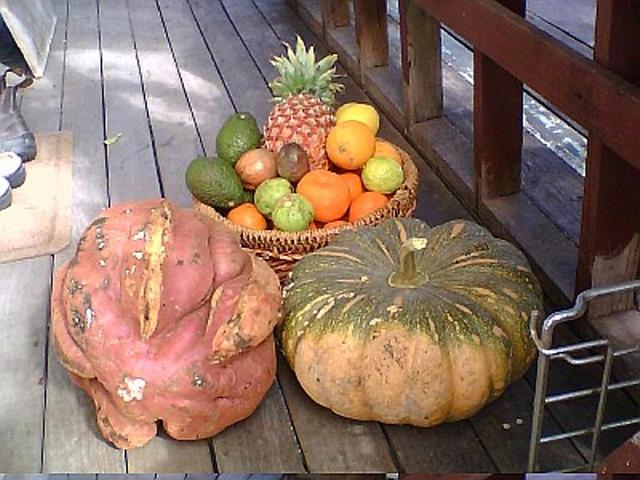Fruits of our land
Early this year, we had floods and a few months after that we had fruits of our land.

[The floorboards are 95mm wide. On the left of a 10kg pumpkin is a 11kg sweet potato (root). In the basket are a pineapple, oranges, avocados, passionfruits, and limes.]
The sweet potato brings into mind a notion of 'obesity in plants'. Yes, plants do get fat. Other questions like: how does obesity affect plants? What are 'normal sizes' for plants, fruits, roots? What things do they have more? Only water? Are these things good for eating or good for anything at all?
We learn from 'giant pumpkins' competitions that giant pumpkins are 'not' edible. These giant pumpkins are bred for size and given a lot of fertilizers or nutrients to grow fat. But, in the market we see that larger fruits and vegetables are more expensive. Why?
Why should we prefer 'fat' fruits and vegetables over 'normal' ones? What are 'right' sizes, anyway? Should we look into amounts of 'our nutritional requirements' in fruits and vegetables and pay for our 'food' by those amounts --rather than their obesity?
We have fruit trees and we pick our fruits when they are 'really' ripe. [Fruits in (super)markets are harvested (all fruits are picked) when a test sample from the whole orchard shows 'certain level of sugar statistically'. Usually, the fruits are a week from being fully ripe.] Our fruits taste sweeter and fuller. (All 'fruits of our labour' taste better anyway, right?) There are chemical differences between 'green' fruits and 'ripe' fruits. Animals (bats, birds, possums, rats and mice, horses, goats and many insects) prefer 'ripe' fruits. Why? Do they know something we don't (care)?
I don't have answers for these questions. Maybe your have something that we can learn. Let us know ;-)
ความเห็น (3)
We learn from stories of 'giant pumpkin' competition that the giant pumpkin are 'not' edible
- In Chiang Mai, my hometown, also have 'big garlic' competition
- However the smaller "กระเทียมโทน" is more expensive that I don't know why ( more delicious, more nutrient?)
- I've seen some supermarket in San Francisco tell amount of nutrtion but no one care since we have to pay by weight anyway.
Thank you Doctor, for adding to the list of questions.
We pay for fresh food by weight and yet we pay for 'processed food' by 'package' (serving, dish, pack, ...).
Do we see fresh food as 'raw materials' and processed food as 'products'?
People say products are results of 'work', 'art' and technologies.
They do not see that farmers put in a lot of 'hard work', 'knowledge' and 'know-how' to produce fresh food.
Recent calls to support farmers 'raise' prices of fresh food; but farmers still get the same low price -- supermarkets and retailers get more profits.
Perhaps, farmers should also process what they grow and sell processed food instead.
They would be able to set prices for their products --by law--.
;-)
A news item caught my eyes. It describes a process to find 'the normal size' (or normal body shape) in animals.
Perhaps, we can get data for our fruits and vegetables from 'social network fans'?
If I say my biggest sweet potato weighs 11 kg,
how heavy is your biggest sweet potato?
And the average weight?
Can you answer with a 'format like' "biggest: 999.99 kg / average: 999.99 kg"
so, I can use a program to pull the data off and add the data to my database?
<<
Weight watchers for London Zoo's animals
27 Aug 2011 - 03:39am
London Zoo keepers have conducted the annual weight and height measurements of all their animals.
How tall or short, fat or thin? London Zoo keepers had their work cut out this week conducting the annual weight and height measurements of all their animals.
It's a monumental task to weigh and measure more than 750 different species, including lions, tigers, penguins and snakes.
First up were the cheeky golden lion headed tamarins, who needed no encouragement to jump all over the specially adapted scales. Getting them on the scales wasn't the problem, it was keeping them there long enough to take a reading.
Senior keeper ... said banana treats usually do the trick.
Cuddly Tammy the tamandua, or tree ant eater, lumbered along to see what all the fuss was about and happily spent a long time on the scales in front of photographers. She weighed in at around 8.5 kilos (19 lbs).
...
The heavyweight of the tortoise world, the giant Galapagos tortoise, 'Dirk' was next up. He came in at a respectable 168.5 kilos (371 lbs). A carrot was all that was needed to get Dirk onto the scales, but some creatures are far more difficult to deal with.
...
The easiest animals are ones who are motivated to anything with the promise of a food treat, but that does mean they are the most likely to be a little red-faced at the rising numbers on the scales during the weigh-in.
The insects are measured rather than weighed. Jacqueline the tarantula was 10 cm (4 inches). The stick insect came in at a round 30cm (12 inches) - the length of the keeper's ruler. Once keepers managed to straighten out Stripey the milk snake, they discovered he was a metre (39 inches) long.
The meticulous recording of heights and weights helps the zoo monitor the animals' health and general well-being.
'Obviously the animals can't tell us if they are poorly, so we do have to keep a very good visual eye on them and weight change, sudden weight change, is a really good indication of any health problems there might be. And also monitoring any possible pregnancies as well,'
The information is shared with other zoos to help better understand each species. The logs of vital statistics help with field conservation projects where wild animals are monitored to better understand behaviour, health and even an animal's age.
>>